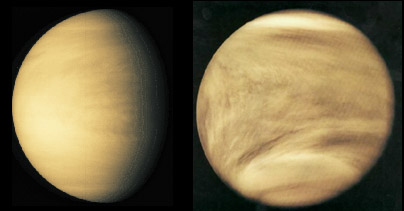
Two views of Venus: image on the left is in the visible band and the image on the right is in the ultraviolet band and colorized to match the visible band image.
Video lecture for this page (Jovian planets only)
This material (including images) is copyrighted!. See my copyright notice for fair use practices. Select the photographs to display the original source in another window.
Most of the planet atmospheres reflect enough of the visible sunlight that only the upper layers of their atmospheres can be seen. Only the Earth and Mars have atmospheres transparent to most of the visible light so that we can see what lies below their atmospheres. I acknowledge that I have a visible light bias in this section---the other planet atmospheres are more transparent at other wavelengths outside of the visible band. If humans had eyes sensitive to certain parts of the infrared, we would probably say that Earth's atmosphere was a thick haze that prevented photography of the surface from space.
In visible light, Venus is a bland, yellow-white planet. Venus' atmosphere is 96 percent carbon dioxide but it is the thick cloud layer of sulfuric acid droplets that reflects back about 70 percent of the sunlight and make Venus brighter than any other object in our sky besides the Moon and the Sun (in fact Venus can be seen in broad daylight if the Earth's atmosphere above you is very clear). Venus' cloud layer extends from 30 kilometers to 60 kilometers above the surface. Below 30 kilometers Venus' atmosphere is clear because the high temperature near the surface evaporates any cloud droplets that drop too far. What sunlight that makes it through the clouds, has an orange tinge to it because the blue colors are absorbed by the clouds. The sulfuric acid may be from sulfur compounds, possibly from volcanoes, that chemically react with the trace amounts of water vapor left in the atmosphere.

The structure of the clouds are revealed in ultraviolet light. It is the ultraviolet images that most astronomy books will use to show what Venus looks like. To see what lies below the surface, astronomers use the long wavelengths of radio. The rocky surface of Venus has been mapped using imaging radar by spacecraft orbiting Venus, such as the spectacular Magellan spacecraft that surveyed Venus in the early 1990's.
Earth's atmosphere is mostly transparent to visible light with a blue tint caused by the preferential scattering of blue sunlight by the nitrogen and oxygen molecules. Clouds of water droplets and ice crystals form up to about 10 kilometers above the surface. The droplets and crystals are large enough to reflect all wavelengths of visible equally, so the clouds have a white color. Because of the coriolis effect (recall the previous section), the clouds form spiral patterns.
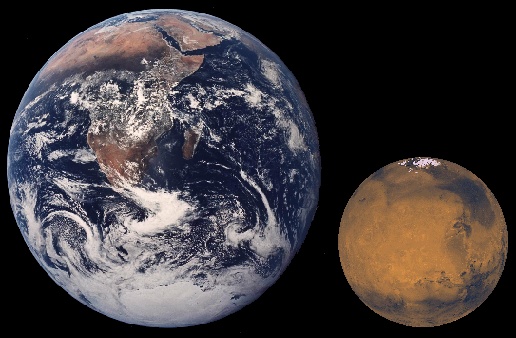
Mars' carbon dioxide atmosphere is also mostly transparent to visible light. Its thin white clouds are mostly water ice crystals. Near the poles the temperature is cold enough that carbon dioxide can freeze to form white clouds of carbon dioxide ice crystals. Some clouds have a yellow color because they are composed of fine dust particles a few micrometers across. Astronomers expected Mars' sky to have a deep blue color as seen from the surface because the atmosphere is only one percent the thickness of the Earth's atmosphere. However, pictures from the Mars surface landers show the martian sky to be pink from sunlight bouncing off dust particles blown off Mars' red surface.
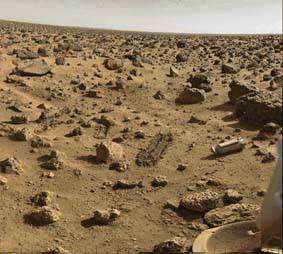 |
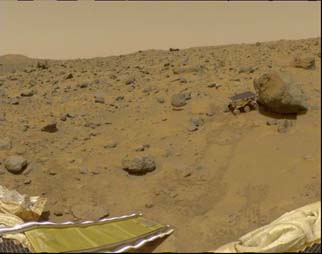 |
Jupiter's atmosphere is very dynamic and colorful and Saturn's atmosphere is a muted version of Jupiter's. Even though their atmospheres are primarily hydrogen and helium, the clouds of ammonia ice crystals in their upper atmospheres give the planets their appearance. The strong coriolis effect from their rapid rotation deflect the clouds into bands parallel to their equators.
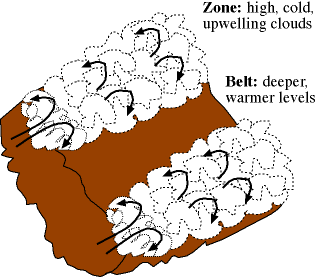
The bright zones on Jupiter are regions of upwelling convection cells in the upper atmosphere with more ammonia clouds than the darker bands. The dark bands are where we see to the warmer clouds made of ammonium hydrosulfide ice crystals about 20 to 30 kilometers below the ammonia cloud deck. Clouds of water ice crystals are thought to exist about 100 kilometers below the ammonia cloud deck, but the Galileo probe that plunged through Jupiter's clouds in early December of 1995 found no water layer. However, this may because the Galileo probe descended through an unusually dry and cloud-free part of the atmosphere.
Saturn's layer of clouds is about twice as thick as Jupiter's because of the colder temperatures and lower gravity compression on Saturn. The strong jet streams in their atmospheres create turbulent eddies of swirling clouds, some several thousands of kilometers across. One spectacular example is the Great Red Spot on Jupiter---a hurricane twice the size of the Earth that has lasted for over 400 years. Such storms and the belted patterns on the jovian planets can last so long because there is no solid surface for the storms to expend their energy.
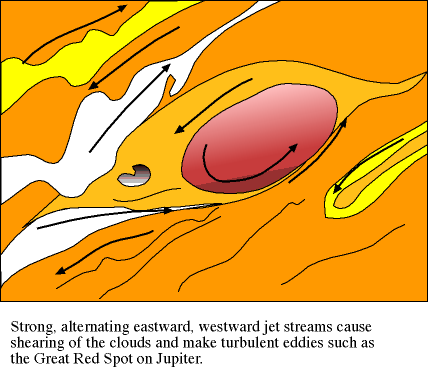 |
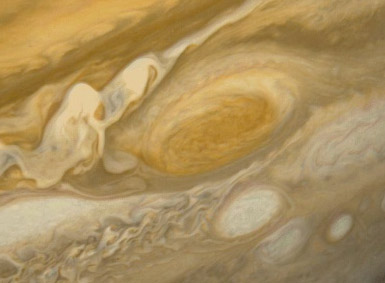 |
What is puzzling about the clouds is their color. The ammonia ice clouds should be white, yet they have a variety or red, orange, yellow, and brown colors. Sunlight striking the clouds causes photochemical reactions with the molecules in the clouds. The resulting organic compounds, or trace amounts of sulfur and phosphorus may be responsible for the colors in the clouds.
Uranus and Neptune also have thick cloud decks but Uranus' atmosphere does not have the prominent bands and storms seen on the other jovian planets. This is because Uranus does not have an extra internal heat source like the other jovian planets, so it does not have the convective motions in its atmosphere. Neptune's clouds are deflected to form bands parallel to its equator because of its rapid rotation. Neptune can also have turbulent eddies form in its atmosphere. When the Voyager spacecraft flew by Neptune in 1989, it found a large dark storm, called the Great Dark Spot (very original, yes?), that was about the size of Jupiter's Great Red Spot. However, recent Hubble Space Telescope photographs show that the Great Dark Spot seems to have dissipated.
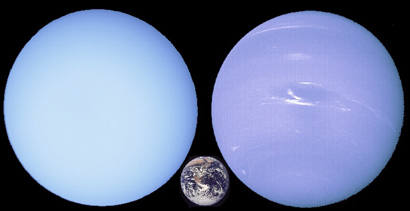
Uranus and Neptune both have a blue color. Instead of ammonia clouds, their clouds are made of frozen methane crystals because they are much colder than Jupiter and Saturn. The red and orange colors of sunlight are absorbed by the methane in their atmospheres while the blue colors are scattered back out, producing the blue color with a faint greenish tinge.
![]() Go back to previous section --
Go back to previous section --
![]() Go to next section
Go to next section
last updated: July 2, 2022